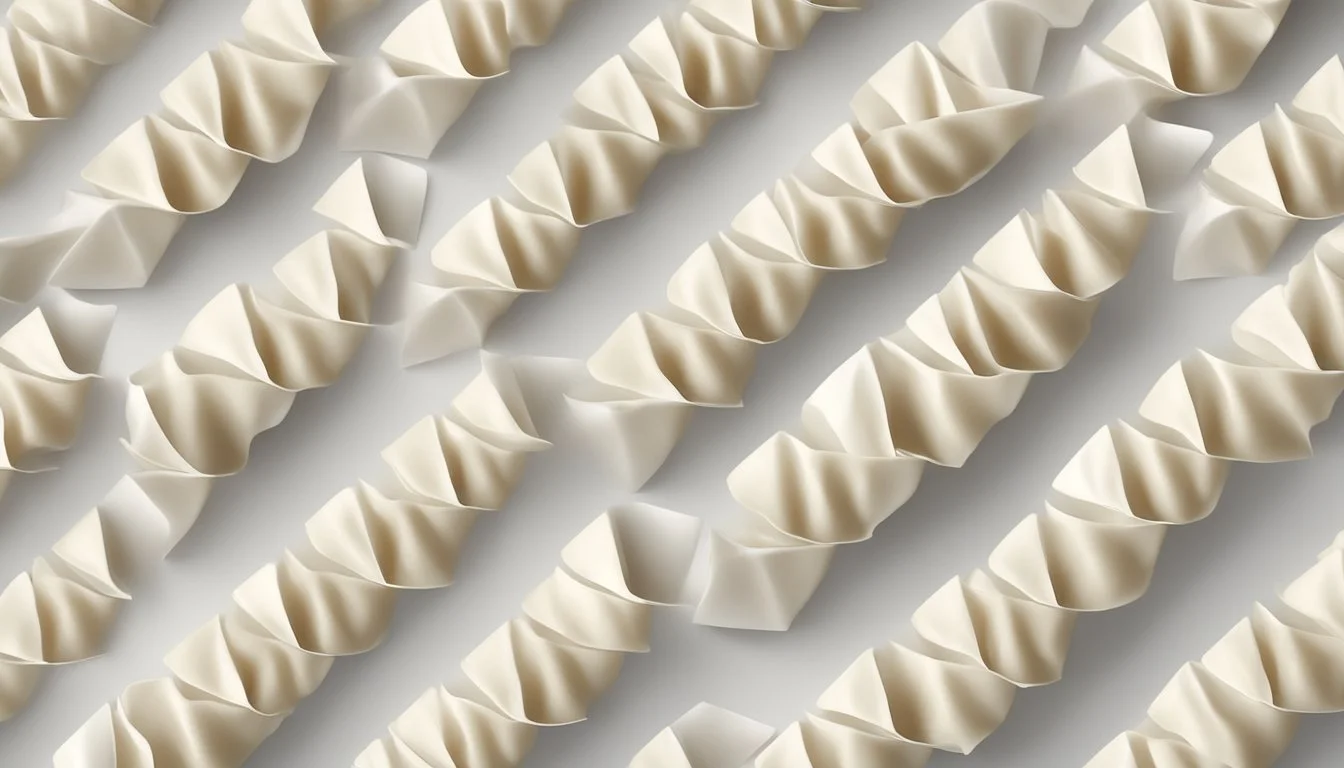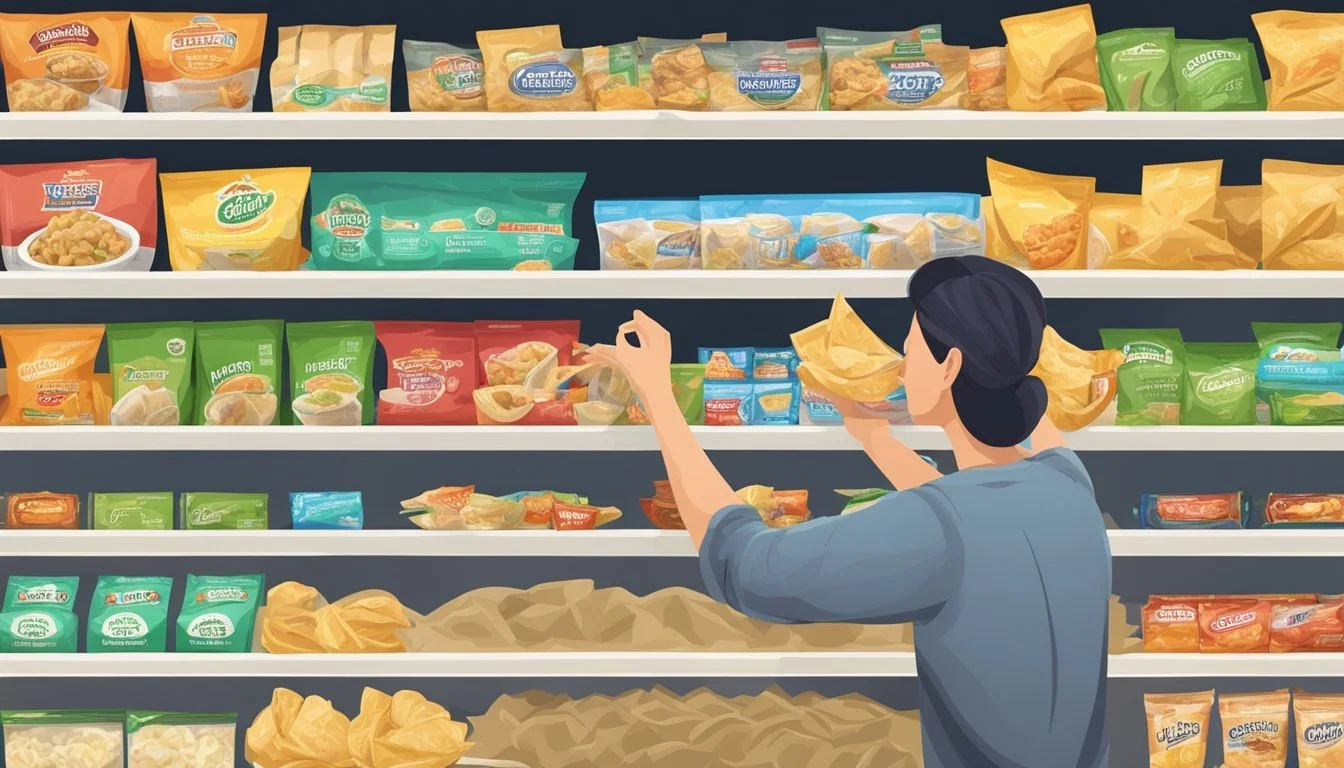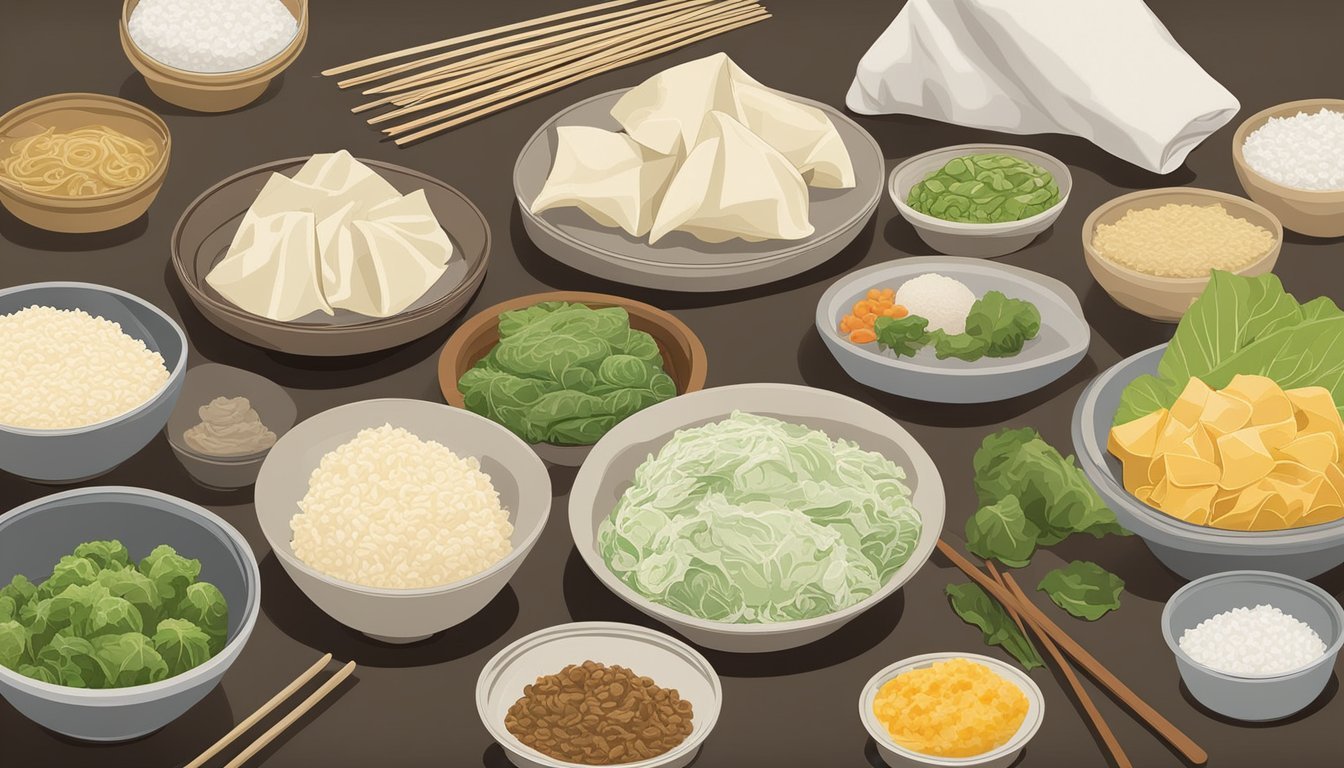Won Ton Wrappers Substitutes
5 Alternative Options for Your Recipes
Wonton wrappers, the thin sheets of dough traditionally used in Chinese cuisine to encase a variety of fillings, are a versatile ingredient in many kitchens. Sometimes known as wonton skins, these wrappers are prized for their delicate texture and slight chewiness when cooked, whether they're boiled, fried, or steamed. Essential for making classic wonton soup, dumplings, and other dim sum favorites, these wrappers are made from a simple dough of flour, eggs, water, and salt, rolled out thinly and cut into squares or circles.
Occasionally, home cooks and professional chefs alike may find themselves in need of a substitute for wonton wrappers. Whether it's due to dietary restrictions, availability issues, or simply a desire to experiment with different textures and flavors, there are several viable alternatives that can hold fillings and maintain integrity during cooking. Substitutes such as rice paper, gyoza wrappers, and even unconventional choices like thinly sliced vegetables or chicken skin can offer a different yet satisfying take on traditional recipes that call for wonton wrappers.
Understanding the properties of wonton wrappers is essential in selecting an appropriate substitute. They should be pliable enough to fold without tearing, strong enough to contain fillings, and subtle in flavor to not overpower the other ingredients in the dish. When a recipe calls for this ingredient, the selected alternative should closely mimic these characteristics. The texture, taste, and cooking method of the substitute will affect the final dish, making it important to consider how each alternative interacts with the other components of the recipe.
Understanding Wonton Wrappers
Wonton wrappers are an essential component in various Asian dishes, known for their delicate texture and distinct taste which play a central role in the culinary experience.
Traditional Ingredients and Texture
The conventional composition of wonton wrappers includes a simple mixture of flour, water, and salt. At times, eggs may be added to the dough to enrich the wrappers with a tender but elastic texture that is crucial for encasing fillings without tearing. The dough is then rolled into thin sheets, offering a texture that is simultaneously chewy and tender when cooked.
Ingredient Purpose Flour Provides structure to the wrapper Water Binds the flour and facilitates elasticity Salt Enhances flavor Eggs Contributes to texture and richness
Common Uses and Cultural Significance
Wonton wrappers are versatile and are used to create a variety of dishes including dumplings, soup, and more. In the shape of little parcels, wontons are a comfort food popular across various regions, each with its own filling variations and cooking methods. The cultural significance of wontons is deep-rooted, often symbolizing prosperity and being a staple during festive seasons like the Chinese New Year. They are not only nourishing but also carry a sentimental essence in Asian culinary traditions.
Dumplings: Typically filled with a mix of meats and spices, then sealed and cooked.
Soup: Small wontons are cooked directly in broth, creating a hearty and comforting dish.
In these applications, the wrapper's ability to maintain integrity while absorbing flavors from broths or sauces is key to the enjoyment of the dish.
Substitutes for Wonton Wrappers
In the absence of traditional wonton wrappers, several alternatives offer comparable texture and flavor, utilizing ingredients ranging from wheat to rice flour. These substitutes can be used to encase a variety of fillings, much like traditional wonton skins.
Gyoza Wrappers
Gyoza wrappers are made from wheat flour and are slightly thicker than wonton wrappers. They provide a chewy texture to dishes and can be a good option for those looking to replicate the consistency of traditional wontons.
Shumai Wrappers
Another wheat flour-based substitute, shumai wrappers are thinner and can offer a more delicate bite. Their pliability makes them versatile for folding around fillings, similar to wonton wrappers.
Spring Roll Wrappers
Spring roll wrappers are traditionally made from wheat flour and offer a crispier texture once cooked. They work well for both fried and baked applications, making them an accessible substitute for wonton wrappers.
Rice Paper
Rice paper, made from rice flour and water, is a gluten-free option with a distinct, slightly chewy texture. While the taste differs from wonton wrappers, it can hold fillings effectively and offer a lighter alternative.
Egg Roll Wrappers
Egg roll wrappers are thicker and larger than wonton wrappers but can be cut down to size. Made with wheat flour and egg, they offer a heartier texture and taste when used as a substitute.
Beancurd Sheet
Beancurd sheets, crafted from soybeans, provide a unique taste and texture that can stand in for wonton wrappers. They usually require soaking before use to achieve the right pliability.
Homemade Options
One can create homemade wonton wrappers using all-purpose flour, water, and salt. This allows for a customizable taste and thickness, and ensures the wrappers will closely match the desired qualities of traditional wonton skins.
Choosing the Right Substitute
When selecting a substitute for wonton wrappers, one needs to consider how the alternative will interact with the intended dish in terms of taste, texture, shape, and thickness.
Considerations Based on Dish
Choosing a substitute for wonton wrappers should be done with an understanding of the dish's requirements. For recipes that call for deep-fried wontons, one may use rice paper because it holds contents effectively and achieves a desirable crispness when fried. In dishes where a delicate, chewy texture is essential, like in soups (What wine goes well with soups?), shumai wrappers are a preferable option due to their similarity in composition and mouthfeel to traditional wonton skins.
Taste and Texture Matching
The taste and texture of the substitute should be as close as possible to the original wonton wrapper to maintain the integrity of the dish. Rice papers are thin with a slight chewiness and a neutral flavor, making them a versatile substitute that can adapt to various fillings and cooking methods. Shumai wrappers, being a blend of cake flour and bread flour, offer a denser texture that can be quite similar to the chewy yet tender bite of a wonton wrapper.
Substitute Taste Texture Rice Paper Neutral Slightly chewy Shumai Wrapper Mildly Flavorful Denser, chewy
Shape and Thickness
The shape and thickness of the substitute can affect both the preparation method and the final presentation of the dish. Rice paper comes in round sheets and needs to be moistened before use, which may require some practice to handle without tearing. Spring roll wrappers are also a good alternative, available in various thicknesses that can be tailored to your dish—thin for less heft, thick for a crunchier texture. They are typically square, closely resembling the shape of wonton wrappers and allowing for similar folding techniques.
Substitute Shape Thickness Rice Paper Round Very thin Spring Roll Wrapper Square Variable
Using the right alternative for wonton wrappers will ensure that the final dish maintains the desired taste and textural qualities. Whether one opts for the mild flavor and thin texture of rice paper, or the thicker, crunchier texture of spring roll wrappers, each substitute has unique attributes that can complement the intended dish.
Creating Substitutes at Home
In seeking alternatives for store-bought wonton wrappers, one has two main paths: crafting homemade wrappers with traditional or alternative flours and ingredients, or experimenting with various household ingredients for a unique twist on the classic dumpling shell.
Homemade Wonton Wrappers
Homemade wonton wrappers provide the closest experience to the traditional wonton skins found in stores and are simple to make with basic pantry items. The essential components of a homemade wrapper are flour and water, with a pinch of salt and a touch of oil to add pliability to the dough. Here is a basic recipe for homemade wonton wrappers:
Ingredients:
2 cups all-purpose flour
1/2 teaspoon salt
1 egg
3/4 cup water
1 teaspoon vegetable oil
Instructions:
Mix the dry ingredients: Combine the all-purpose flour and salt in a bowl.
Add wet ingredients: Make a well in the flour, add the beaten egg, water, and oil, and mix to form a dough.
Knead the dough: Turn the dough onto a floured surface and knead until smooth, around 5 minutes.
Rest the dough: Cover the dough in plastic wrap and let it rest for at least 20 minutes.
Rolling out: Roll the dough to the desired thinness, then cut into squares or circles.
Cook immediately or store: These homemade wrappers can be used immediately or stored in the refrigerator with a dusting of cornstarch to prevent sticking.
Alternative Flours and Ingredients
For those with dietary restrictions or looking for a healthier twist, alternative flours can be employed to create vegan or gluten-free wonton wrappers. Substituting all-purpose flour with a blend of gluten-free flours can yield a similar texture with the right adjustments. Flours such as rice flour or a mix of gluten-free baking flour and xanthan gum, which acts as a binding agent, can be used.
Vegan Wonton Wrapper Ingredients:
2 cups gluten-free flour blend or rice flour
1/2 teaspoon salt
3/4 cup warm water
Cornstarch for dusting
To maintain a neutral and clear flavor profile, it's recommended to avoid strongly flavored oils or flours that could overpower the filling. Whether using traditional or alternative ingredients, the process of mixing, kneading, resting, rolling, and cutting follows the same fundamental steps as making standard homemade wonton wrappers.
By creating homemade wonton wrappers, one ensures a fresh, preservative-free product that can be customized to suit any dietary need.
Accommodating Dietary Restrictions
For individuals with dietary limitations, finding suitable wonton wrapper substitutes that are both vegan and gluten-free can be essential. These alternatives not only adhere to dietary needs but also allow for the enjoyment of traditional dishes with a new twist.
Vegan and Gluten-Free Substitutes
Rice Paper Wrappers: A popular choice for those seeking a gluten-free alternative, rice paper is made primarily from rice flour, water, and salt. It's notably thin and becomes pliable when moistened, which is ideal for rolling. Rice paper's neutral flavor complements a wide variety of fillings without overshadowing their taste.
Pros:
Gluten-free
Neutral taste
Flexible when wet
Cons:
Different texture from traditional wonton wrappers
May tear if not handled properly
Tofu Wrappers: Tofu skins, also known as yuba, are made from the skin that forms on the surface of boiling soy milk. These are a protein-rich, vegan option that can mimic the chewy texture of traditional wonton skins after cooking.
Pros:
High in protein
Vegan
Mimics traditional texture
Cons:
More fragile compared to conventional wrappers
Distinct soy flavor that may not suit all dishes
For those seeking vegan wonton wrappers, it should be noted that traditional wrappers often contain egg, thus they must check for specific vegan alternatives. Labels on such products typically specify whether they are free from animal products, helping to ensure that dietary restrictions are respected.
Related Ingredients and Storage Tips
When venturing into the realm of Asian cuisine, one can find a variety of wrappers akin to wonton skins, each with unique applications. Understanding the storage and shelf life of these ingredients is just as critical to maintaining their quality and texture.
Comparable Asian Wrappers and Their Uses
Gyoza Wrappers:
Uses: Predominantly used for Japanese dumplings known as gyoza.
Texture: Slightly thicker than wonton wrappers.
Shumai Wrappers:
Uses: Ideal for open-topped Chinese dumplings called shumai.
Texture: Thinner and more delicate, made for steaming rather than frying.
Spring Roll Wrappers:
Uses: A staple for making spring rolls, both fried and non-fried versions.
Texture: Thinner and more pliable, often made from rice or wheat flour.
Shoppers can usually find these wrappers at their local Asian grocery store, often located near other refrigerated dough products or in the freezer section.
Proper Storage and Shelf Life
Wonton Wrappers:
To Store: Keep in the refrigerator, sealed tightly to prevent them from drying out.
Shelf Life: Lasts for about one week in the refrigerator and up to 3 months in the freezer when stored properly.
Gyoza, Shumai, and Spring Roll Wrappers:
To Store: Similar to wonton wrappers, they must be kept refrigerated or frozen, in an airtight packaging to retain moisture.
Shelf Life: Typically, they will stay fresh for a week in the fridge, but can be kept for several months in the freezer.
It is recommended to mark the date of purchase on the packaging for monitoring purposes and ensure optimal freshness. Upon thawing frozen wrappers, one should never refreeze them as it can deteriorate their quality.
To maintain the integrity of these Asian wrappers, always refer to the storage instructions on the product's packaging, as variations can occur between manufacturers.
Innovative Uses for Wrapper Substitutes
When traditional wonton wrappers are unavailable, a variety of alternative ingredients can provide a unique twist to classic recipes. These substitutes not only mimic the texture and practicability of wonton skins but also introduce new flavors and nutritional elements to dishes.
Non-Traditional Recipes and Ideas
Vegetable Wraps: Thin slices of cabbage leaves or blanched collard greens can be used as a healthy, gluten-free option to wrap fillings. They lend a subtle, sweet flavor and increase the dish's vitamin content.
Example: Cabbage leaf parcels filled with a spiced mixture of ground pork, mushrooms, and carrots offer a nutritious twist to the traditional wonton.
Seafood-Based Dumplings: For a seafood variation, thinly sliced shrimp or fish can envelop savory fillings, providing a delicate texture and a boost of omega-3 fatty acids.
Example: Shrimp sheets wrapped around a mixture of minced shrimp, ginger, and chives, steamed to perfection, make for an inventive seafood dumpling.
Poultry Wraps: Translucent slices of chicken skin can be crisped and used as a crunchy casing for a variety of stuffings such as ground beef, vegetables, or seasoned seafood.
Example: Crispy chicken skin stuffed with a mixture of ground chicken, cilantro, and diced water chestnuts, then baked until golden, creates a flavorful and texturally pleasing appetizer.
Meat-Based Wontons: For those who prefer a meatier bite, thin sheets of beef or pork serve as a substantial alternative to traditional wrappers. They contribute a richer taste and ample protein.
Example: Paper-thin beef slices rolled around a flavorful blend of minced beef, onion, and spices, then grilled or broiled, present a carnivorous take on the classic wonton.
These innovative ideas show that with a bit of creativity, substitutes for wonton wrappers can lead to new culinary discoveries while accommodating dietary preferences and restrictions.
Culinary Techniques
When substituting wonton wrappers, chefs must consider how alternative materials affect folding and sealing techniques, as well as how they interact with different cooking methods. Each substitute requires a nuanced approach to maintain the integrity of the original dish.
Folding and Sealing
The flexibility of a substitute plays a crucial role in replicating wonton shapes. Shumai wrappers, similar in composition to wonton skins, offer a comparable texture that can hold up to intricate folds. They can be folded into traditional wonton shapes or used for other styles like summer rolls, where a tight seal is essential to prevent the filling from escaping during cooking.
Deep-fry: Ensure substitutes like shumai wrappers are properly sealed to prevent oil seepage.
Soup: A secure seal is necessary to keep savory or sweet fillings intact in a broth.
Cooking Methods
Different substitutes react uniquely to cooking techniques, such as deep-frying or boiling in soups. Rice paper is a notable example, typically associated with Vietnamese spring rolls. To achieve a texture closer to that of deep-fried wontons, rice papers can be fried before use.
Deep-fry: Substitutes like rice paper require a brief soak in water pre-frying to prevent tearing.
Substitute Prep Notes Cooking Method Rice Paper Soak in water; can be pre-fried Deep-fry or steam Shumai Wrappers Ready to use; ensure tight seal Deep-fry or steam
Soup: Consider the wrapper's ability to maintain consistency when submerged in broth.
Savory Fillings: Use substitutes that complement the flavors of the soup's base.
Sweet Fillings: Opt for neutral-tasting substitutes to not overpower the delicate sweetness.








